The Impact of Vegetation Successional Status on Slope Runoff Erosion in the Loess Plateau of China
Abstract
1. Introduction
2. Materials and Methods
2.1. Study Area
2.2. Experiments and Tests
2.3. Vegetation Community Survey and Sample Collection
2.4. Sample Testing
2.5. Data Analysis
2.5.1. Vegetation Community Index
2.5.2. Calculation of Hydrodynamic Parameters
2.5.3. Grey Correlation Analysis
3. Results
3.1. Vegetation Succession Sequence and Structural Characteristics of Ground/Underground Parts
3.2. Dynamic Characteristics of Slope Runoff in Different Vegetation Communities
3.3. Runoff and Sediment Yield under Different Vegetation Communities
3.4. Grey Correlation Analysis between Hydrodynamic Parameters and Ecological Factors of Vegetation Communities
4. Discussion
4.1. Effects of Vegetation Community Restoration on Soil Structure and Erosion
4.2. Effects of Vegetation Community Restoration on the Hydrodynamics of Slope Runoff
4.3. Implications for the Relationship between Vegetation Community Restoration and Slope Erosion
5. Conclusions
Author Contributions
Funding
Acknowledgments
Conflicts of Interest
References
- Chang, E.; Li, P.; Li, Z.; Xiao, L.; Zhao, B.; Su, Y.; Feng, Z. Using water isotopes to analyze water uptake during vegetation succession on abandoned cropland on the Loess Plateau, China. CATENA 2019, 181, 104095. [Google Scholar] [CrossRef]
- Shi, P.; Zhang, Y.; Ren, Z.; Yu, Y.; Li, P.; Gong, J. Land-use changes and check dams reducing runoff andsediment yield on the Loess Plateau of China. Sci. Total Environ. 2019, 664, 984–994. [Google Scholar] [CrossRef] [PubMed]
- Zhao, B.; Li, Z.; Peng, L.; Xu, G.; Gao, H.; Cheng, Y.; Chang, E.; Yuan, S.; Yi, Z.; Feng, Z. Spatial distribution of soil organic carbon and its influencing factors under the condition of ecological construction in a hilly-gully watershed of the Loess Plateau, China. Geoderma 2017, 296, 10–17. [Google Scholar] [CrossRef]
- Ministry of Water Resources. Chinese River Sediment Bulletin; China Science Press: Beijing, China, 2018; pp. 3–4.
- Yellow River Conservancy Commission of the Ministry of Water Resources. Yellow River Basin Comprehensive Planning (2012–2030); Yellow River Water Conservancy Press: Zhengzhou, China, 2013; pp. 15–25. [Google Scholar]
- Chen, Y.P.; Wang, K.B.; Lin, Y.S.; Shi, W.Y.; Song, Y.; He, X.H. Balancing green and grain trade. Nat. Geosci. 2015, 8, 739–741. [Google Scholar] [CrossRef]
- Zhang, X.P.; Lin, P.F.; Chen, H.; Yan, R.; Zhang, J.J.; Yu, Y.P.; Liu, E.J.; Yang, Y.H.; Zhao, W.H.; Lv, D.; et al. Understanding land use and cover change impacts on run-off and sediment load at flood events on the Loess Plateau, China. Hydrol. Process. 2018, 32, 576–589. [Google Scholar] [CrossRef]
- Gao, P.; Jiang, G.T.; Wei, Y.P.; Mu, X.M.; Wang, F.; Zhao, G.J.; Sun, W.Y. Streamflow regimes of the Yanhe River under climate and land use change, Loess Plateau, China. Hydrol. Process. 2015, 29, 2402–2413. [Google Scholar] [CrossRef]
- Chen, H.; Cai, Q. Impact of hillslope vegetation restoration on gully erosion induced sediment yield. Sci. China Ser. D 2006, 49, 176–192. [Google Scholar] [CrossRef]
- Zhou, P. A Study on Rainstorm Causing Soil Erosion in the Loess Plateau. J. Soil Water Conserv. 1992, 6, 1–5. [Google Scholar]
- Schiavon, S.; Zecchin, R. Climate Change 2007: The Physical Science Basis. South African Geographical Journal Being A Record of the Proceedings of the South African. Geogr. Soc. 2007, 92, 86–87. [Google Scholar]
- Gao, H.; Li, Z.; Li, P.; Ren, Z.; Yang, Y.; Wang, J. Paths and prevention of sediment during storm-runoff on the Loess Plateau: Based on the rainstorm of 2017-07-26 in Wuding River. Sci. Soil Water Conserv. 2018, 16, 66–72. [Google Scholar]
- Zhang, J.T. Succession analysis of plant communities in abandoned croplands in the eastern Loess Plateau of China. J. Arid Environ. 2005, 63, 458–474. [Google Scholar] [CrossRef]
- Zhou, J.; Fu, B.J.; Gao, G.Y.; Lu, Y.H.; Liu, Y.; Lu, N.; Wang, S. Effects of precipitation and restoration vegetation on soil erosion in a semi-arid environment in the Loess Plateau, China. CATENA 2016, 137, 1–11. [Google Scholar] [CrossRef]
- Xiao, L.; Yao, K.; Li, P.; Liu, Y.; Chang, E.; Zhang, Y.; Zhu, T. Increased soil aggregate stability is strongly correlated with root and soil properties along a gradient of secondary succession on the Loess Plateau. Ecol. Eng. 2020, 143, 105671. [Google Scholar] [CrossRef]
- Xiao, L.; Liu, G.; Li, P.; Xue, S. Direct and indirect effects of elevated CO2 and nitrogen addition on soil microbial communities in the rhizosphere of Bothriochloa ischaemum. J. Soils Sediments 2019, 19, 3679–3687. [Google Scholar] [CrossRef]
- Rutigliano, F.A.; D’Ascoli, R.; De Santo, A.V. Soil microbial metabolism and nutrient status in a Mediterranean area as affected by plant cover. Soil Biol. Biochem. 2004, 36, 1719–1729. [Google Scholar] [CrossRef]
- Chang, E.; Li, P.; Xiao, L.; Xu, G.; Zhao, B.; Su, Y.; Feng, Z. The characteristics of root system behavior in vegetation succession in Loess Hilly and Gully Region. Acta Ecol. Sin. 2019, 39, 2090–2100. [Google Scholar]
- Wang, T.; Li, P.; Liu, Y.; Hou, J.M.; Li, Z.B.; Ren, Z.P.; Cheng, S.D.; Zhao, J.H.; Reinhard, H. Experimental investigation of freeze-thaw meltwater compound erosion and runoff energy consumption on loessal slopes. Catena 2020, 185, 104310. [Google Scholar] [CrossRef]
- Wang, B.; Zhang, G.H. Quantifying the Binding and Bonding Effects of Plant Roots on Soil Detachment by Overland Flow in 10 Typical Grasslands on the Loess Plateau. Soil Sci. Soc. Am. J. 2017, 81, 1567–1576. [Google Scholar] [CrossRef]
- Shi, P.; Qin, Y.; Liu, Q.; Zhu, T.; Li, Z.; Li, P.; Ren, Z.; Liu, Y.; Wang, F. Soil respiration and response of carbonsource changes to vegetation restoration in the Loess Plateau, China. Sci. Total Environ. 2019, in press. [Google Scholar] [CrossRef]
- Jiao, F.; Wen, Z.-M.; An, S.-S. Changes in soil properties across a chronosequence of vegetation restoration on the Loess Plateau of China. Catena 2011, 86, 110–116. [Google Scholar] [CrossRef]
- Wang, T.; Li, P.; Hou, J.M.; Li, Z.B.; Ren, Z.P.; Cheng, S.D.; Xu, G.C.; Su, Y.Y.; Wang, F.C. Response of the Meltwater Erosion to Runoff Energy Consumption on Loessal Slopes. Water 2018, 10, 1522. [Google Scholar] [CrossRef]
- Martorell, C.; Almanza-Celis, C.A.I.; Pérez-García, E.A.; Sánchez-Ken, J.G. Co-existence in a species-rich grassland: Competition, facilitation and niche structure over a soil depth gradient. J. Veg. Sci. 2015, 26, 674–685. [Google Scholar] [CrossRef]
- Meng, K.; Jiao, J.; Yin, Q.; Wang, N.; Wang, Z.; Li, Y.; Yu, W.; Wei, Y.; Yan, F.; Cao, B. Successional Trajectory Over 10 Years of Vegetation Restoration of Abandoned Slope Croplands in the Hill-Gully Region of the Loess Plateau. Land Degrad. Dev. 2016, 27, 919–932. [Google Scholar]
- Nearing, M.A.; Simanton, J.R.; Norton, L.D.; Bulygin, S.J.; Stone, J. Soil erosion by surface water flow on a stony, semiarid hillslope. Earth Surf. Process. Landf. 2015, 24, 677–686. [Google Scholar] [CrossRef]
- Liu, X.; Wang, F.; Yang, S.; Li, X.; Ma, H.; He, X. Sediment reduction effect of level terrace in the hilly-gully region in the Loess Plateau. J. Hydraul. Eng. 2014, 45, 793–800. [Google Scholar]
- Zhang, G.H.; Luo, R.T.; Ying, C.; Shen, R.C.; Zhang, X.C. Correction factor to dye-measured flow velocity under varying water and sediment discharges. J. Hydrol. 2010, 389, 205–213. [Google Scholar] [CrossRef]
- Zhang, B.Q.; He, C.S.; Burnham, M.; Zhang, L.H. Evaluating the coupling effects of climate aridity and vegetation restoration on soil erosion over the Loess Plateau in China. Sci. Total Environ. 2016, 539, 436–449. [Google Scholar] [CrossRef]
- Peng, X.; Shi, D.; Dong, J.; Wang, S.; Li, Y. Runoff erosion process on different underlying surfaces from disturbed soils in the Three Gorges Reservoir Area, China. CATENA 2014, 123, 215–224. [Google Scholar] [CrossRef]
- Zuazo, V.H.D.; Pleguezuelo, C.R.R. Soil-erosion and runoff prevention by plant covers. A review. Agron. Sustain. Dev. 2008, 28, 65–86. [Google Scholar] [CrossRef]
- Li, P.; Zhao, Z.; Li, Z. Vertical root distribution characters of Robinia pseudoacacia on the Loess Plateau in China. J. For. Res. 2004, 15, 87–92. [Google Scholar]
- Jordan, A.; Zavala, L.M.; Gil, J. Effects of mulching on soil physical properties and runoff under semi-arid conditions in southern Spain. CATENA 2010, 81, 77–85. [Google Scholar] [CrossRef]
- Wang, C.; Ouyang, H.; Maclaren, V.; Yin, Y.; Shao, B.; Boland, A.; Tian, Y. Evaluation of the economic and environmental impact of converting cropland to forest: A case study in Dunhua county, China. J. Environ. Manag. 2007, 85, 746–756. [Google Scholar] [CrossRef] [PubMed]
- Zhi, D.; Hongli, L.I.; Guoyong, R.E.N.; Gang, L.I.U.; Lin, M.A. Study on Soil Amelioration Effect of Planting Grasses in Wind—Sandy Land of Yellow River Floodplain. Chin. J. Grassl. 2008, 30, 84–87. [Google Scholar]
- Bai, Y.F.; Xingguo, H.; Jianguo, W.; Zuozhong, C.; Linghao, L. Ecosystem stability and compensatory effects in the Inner Mongolia grassland. Nature 2004, 431, 181–184. [Google Scholar] [CrossRef]
- Li, Y.Y.; Shao, M.A. Change of soil physical properties under long-term natural vegetation restoration in the Loess Plateau of China. J. Arid Environ. 2006, 64, 77–96. [Google Scholar] [CrossRef]
- Chen, L.; Huang, Z.; Jie, G.; Fu, B.; Huang, Y. The effect of land cover/vegetation on soil water dynamic in the hilly area of the loess plateau, China. CATENA 2007, 70, 200–208. [Google Scholar] [CrossRef]
- Lu, R.; Liu, Y.F.; Jia, C.; Huang, Z.; Liu, Y.; He, H.H.; Liu, B.R.; Wang, Z.J.; Zheng, J.Y.; Wu, G.L. Effects of mosaic-pattern shrub patches on runoff and sediment yield in a wind-water erosion crisscross region. CATENA 2019, 174, 199–205. [Google Scholar] [CrossRef]
- Xin, Z.B.; Xu, J.X.; Zheng, W. Spatiotemporal variations of vegetation cover on the Chinese Loess Plateau (1981–2006): Impacts of climate changes and human activities. Sci. China 2008, 51, 67–78. [Google Scholar] [CrossRef]
- Jiao, J.; Wang, Z.; Wei, Y.; Yuan, S.; Cao, B.; Li, Y. Characteristics of erosion sediment yield with extreme rainstorms in Yanhe Watershed based on field measurement. Trans. Chin. Soc. Agric. Eng. 2017, 33, 159–167. [Google Scholar]
- Sasaki, Y.; Fujii, A.; Asai, K. Soil creep process and its role in debris slide generation—Field measurements on the north side of Tsukuba Mountain in Japan. Eng. Geol. 2000, 56, 163–183. [Google Scholar] [CrossRef]
- Wang, L.; Yao, W.; Shen, Z.; Yang, C. Effects of grass coverage on shallow flow hydraulic parameters and sediment reduction. Sci. Soil Water Conserv. 2009, 7, 80–83. [Google Scholar]
- Govers, G. Relationship between discharge, velocity and flow area for rills eroding loose, non-layered materials. Earth Surf. Process. Landf. 2010, 17, 515–528. [Google Scholar] [CrossRef]
- Quinton, J.N.; Edwards, G.M.; Morgan, R.P.C. The influence of vegetation species and plant properties on runoff and soil erosion: Results from a rainfall simulation study in SE Spain. Soil Use Manag. 2010, 13, 143–148. [Google Scholar] [CrossRef]
- Yan, Y.C.; Xin, X.P.; Xu, X.L.; Wang, X.; Yang, G.X.; Yan, R.R.; Chen, B.R. Quantitative effects of wind erosion on the soil structure and soil nutrients under different vegetation coverage in a semiarid steppe of northern China. Plant Soil 2013, 369, 585–598. [Google Scholar] [CrossRef]
- Zhang, P.; Yao, W.Y.; Liu, G.B.; Xiao, P.Q. Experimental study on soil erosion prediction model of loess slope based on rill morphology. CATENA 2019, 173, 424–432. [Google Scholar] [CrossRef]
- Pimentel, D. Soil Erosion: A Food and Environmental Threat. Environ. Dev. Sustain. 2006, 8, 119–137. [Google Scholar] [CrossRef]
- Zhu, L.Q. Study on soil erosion and its effects on agriculture sustainable development in west Henan province loess hilly areas. J. Food Agric. Environ. 2013, 11, 906–908. [Google Scholar]
- Zhao, B.H.; Li, Z.B.; Li, P.; Cheng, Y.T.; Gao, B. Effects of ecological construction on the transformation of different water types on Loess Plateau, China. Ecol. Eng. 2019, in press. [Google Scholar] [CrossRef]
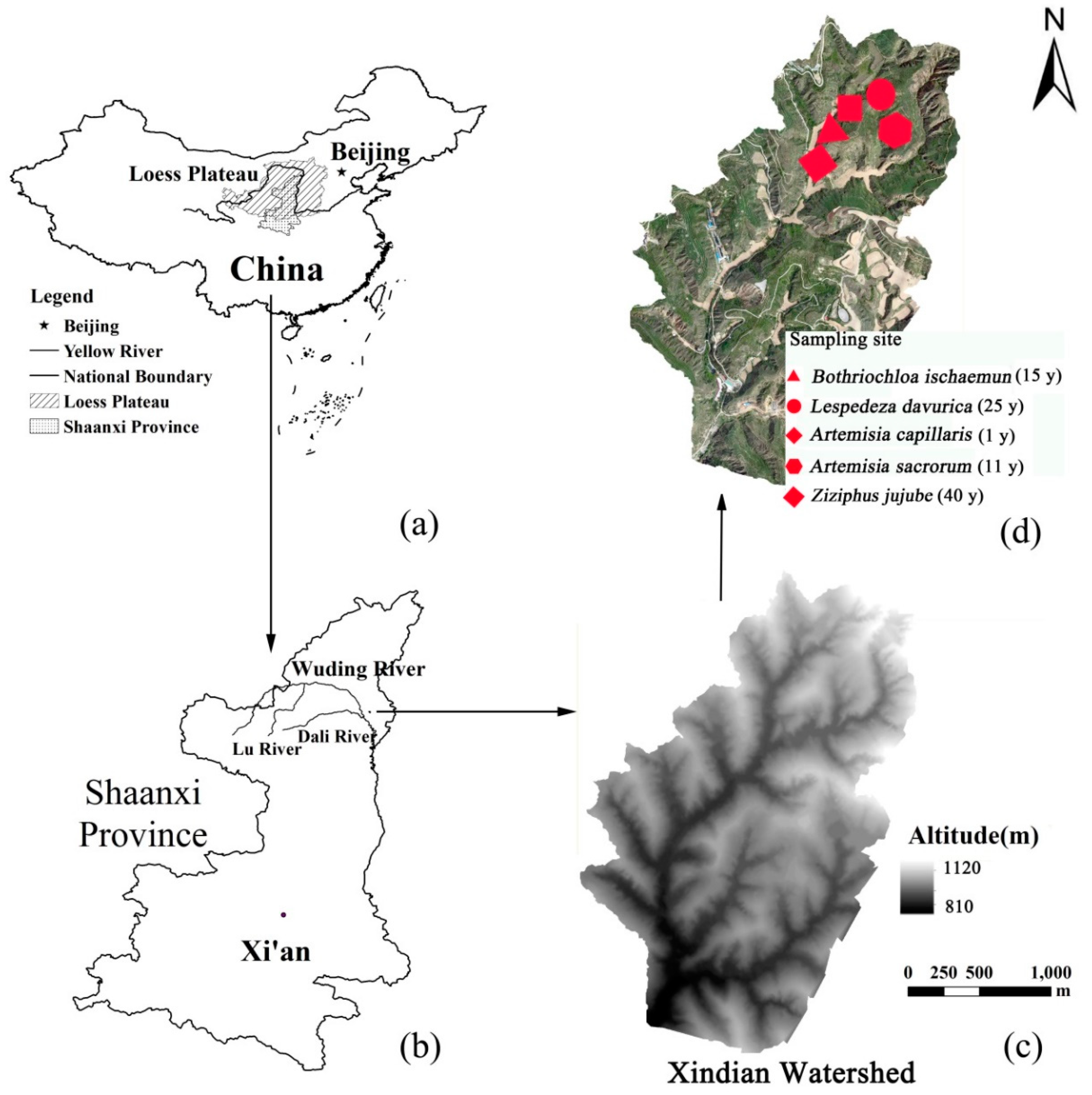
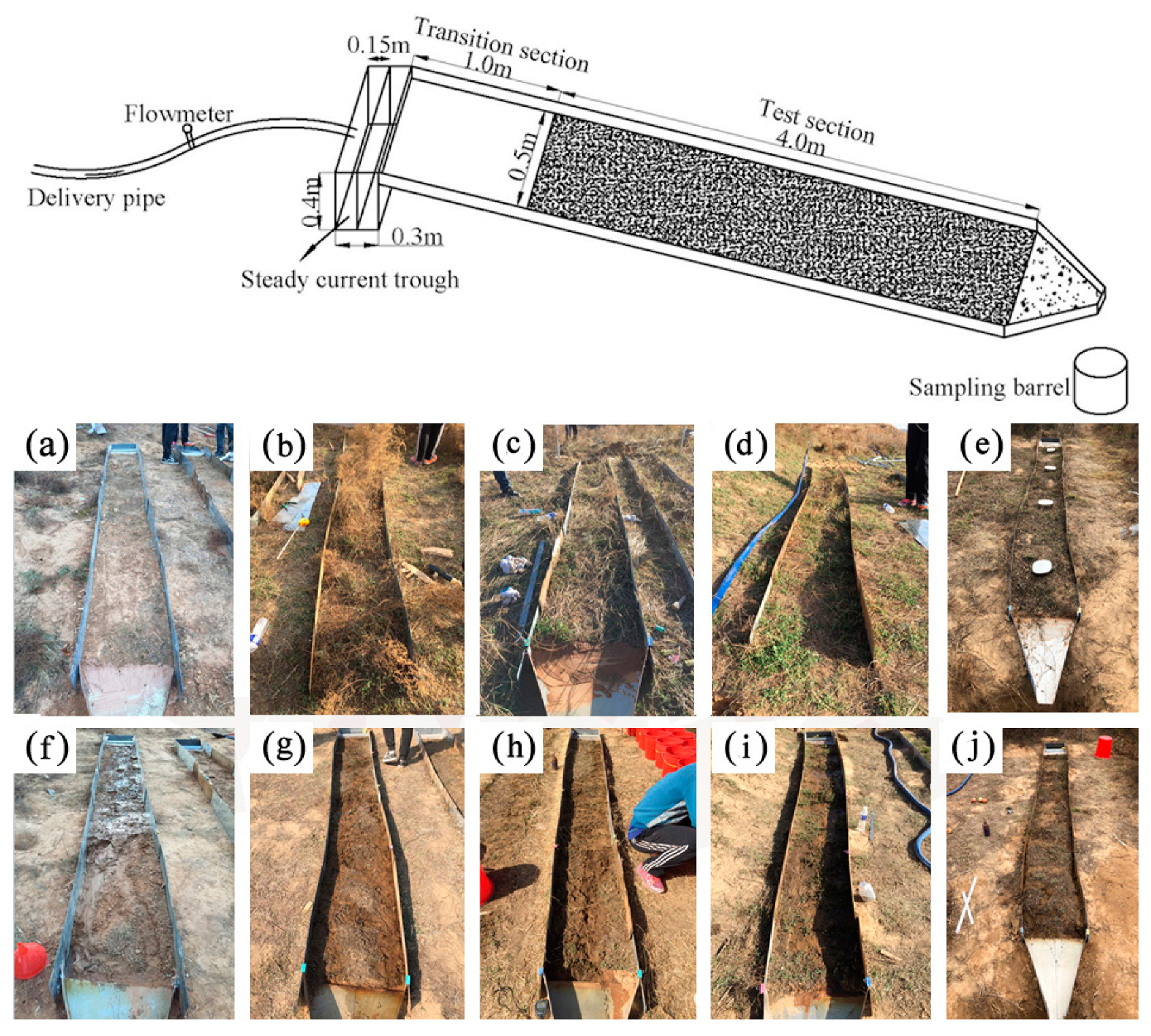

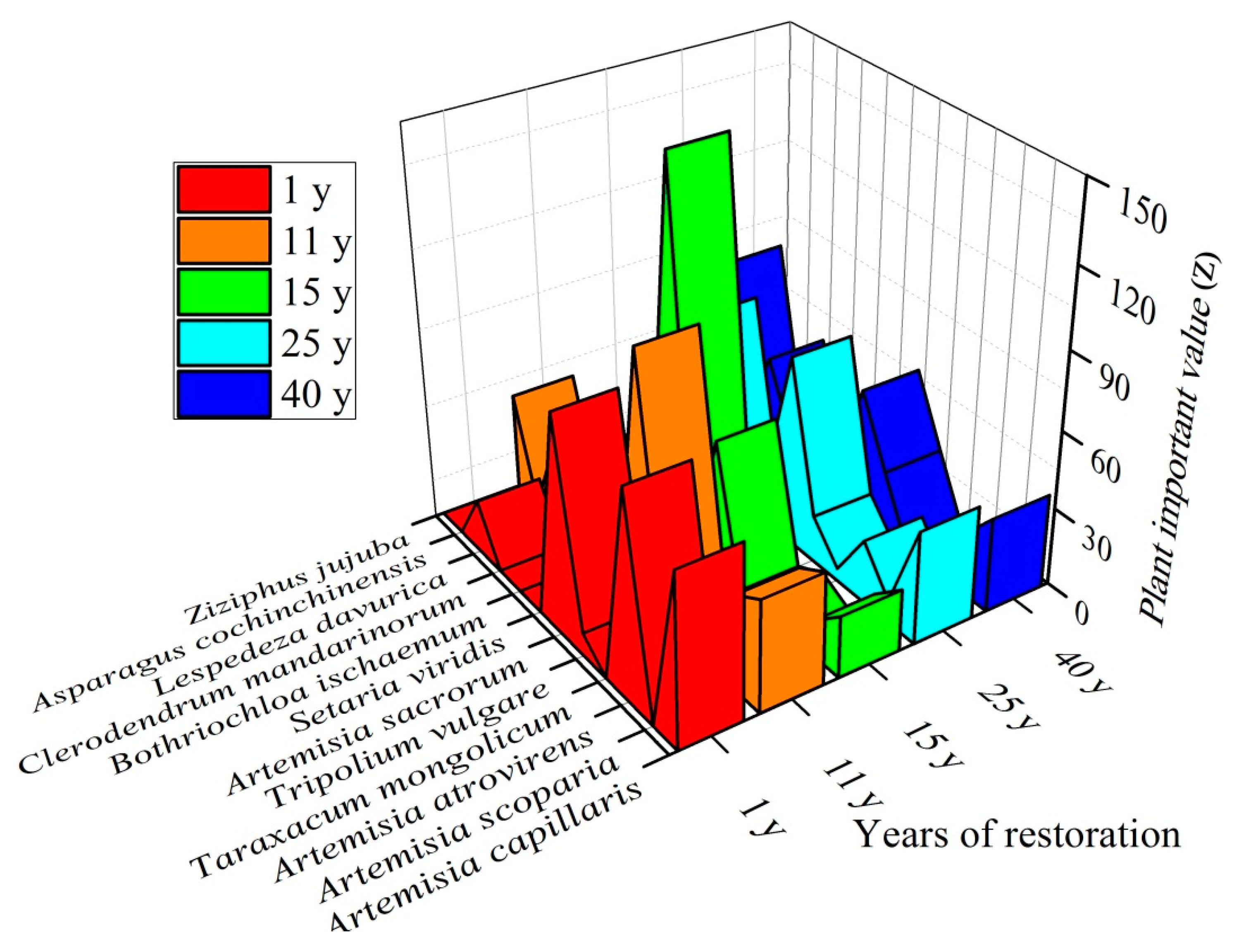
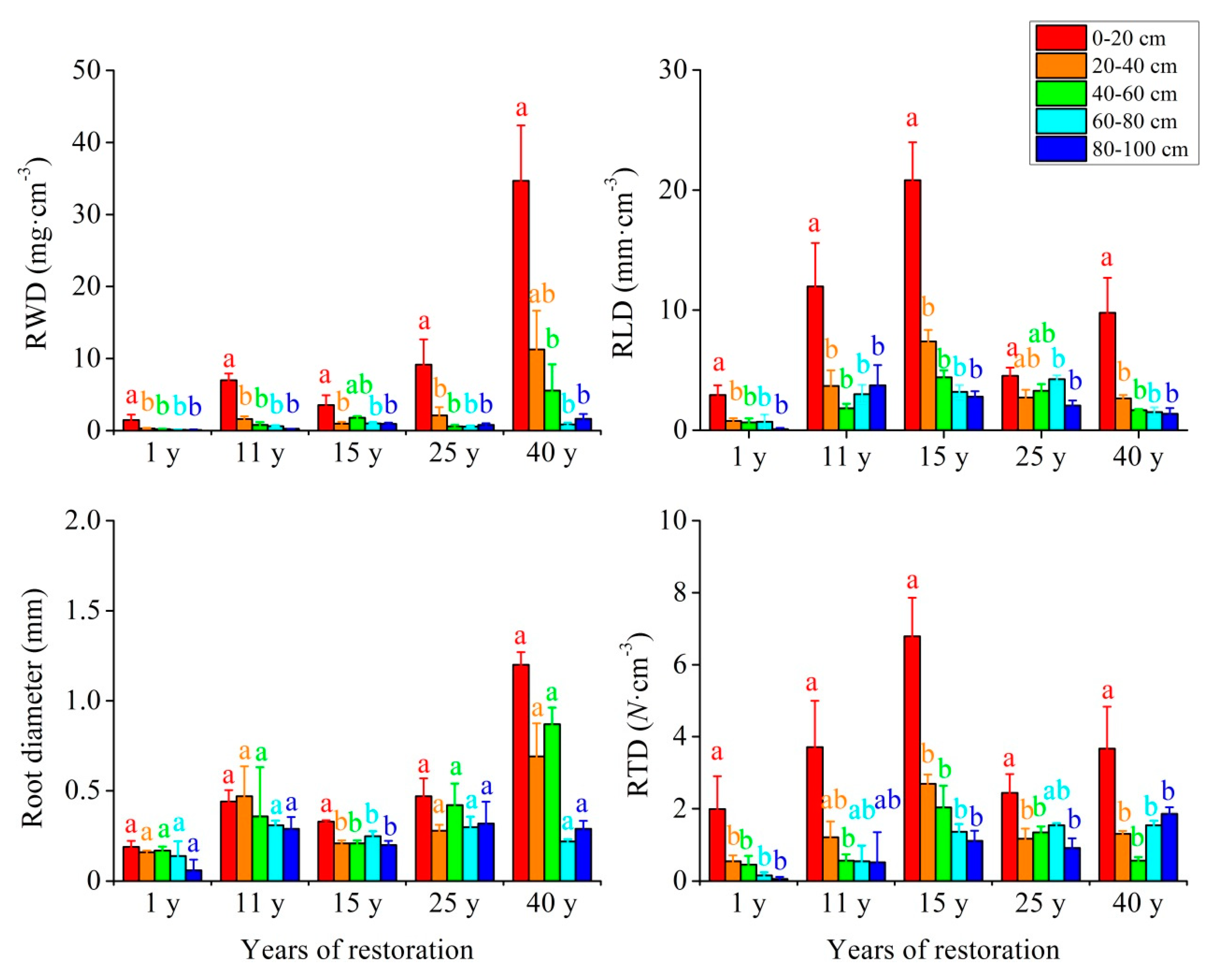
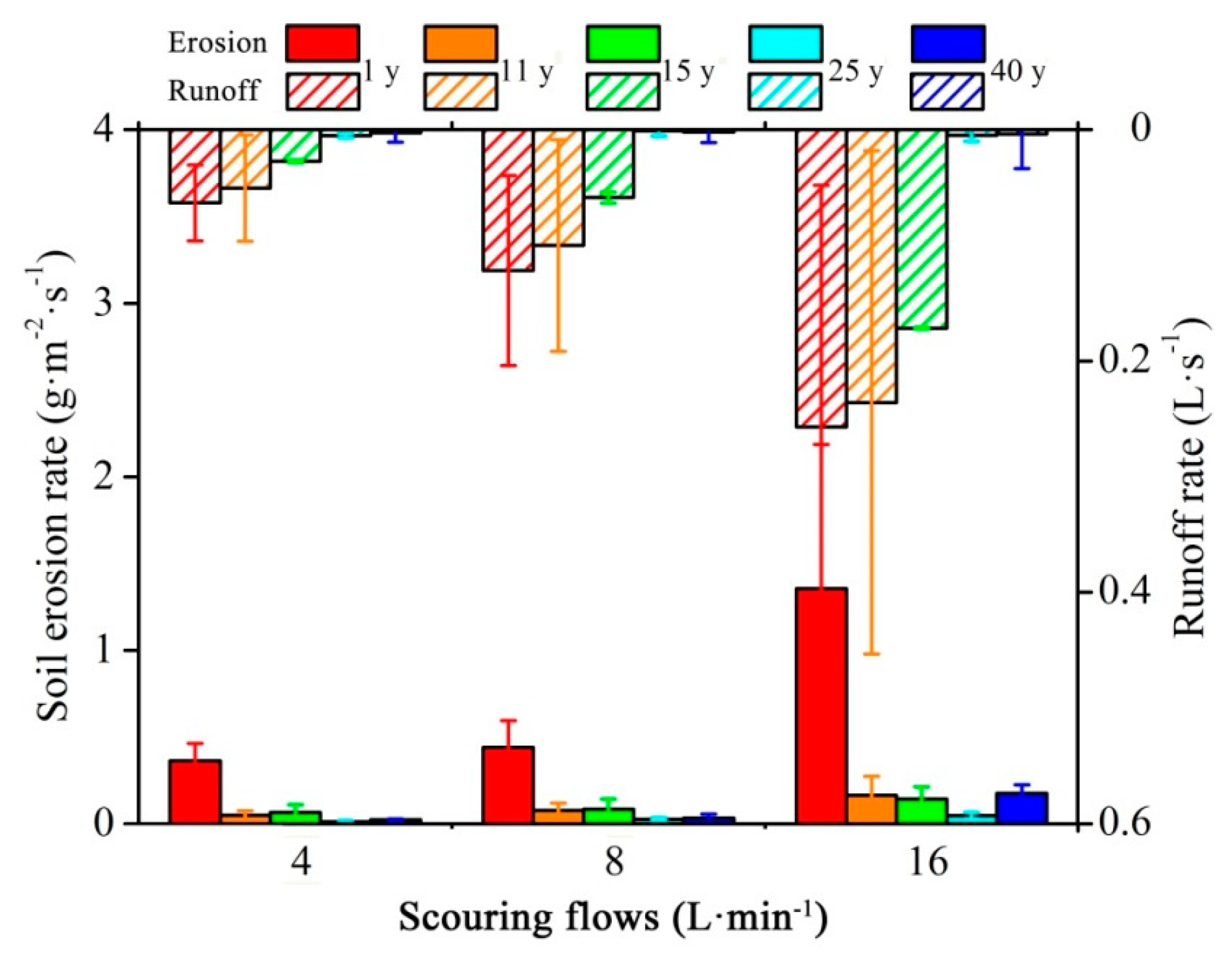
| Years after Restoration/y | Dominant Species | Vegetation Type | Altitude/m | Slope Aspect | Slope/(°) | Vegetation Coverage/% | Humus Thickness/cm | Associated Species |
|---|---|---|---|---|---|---|---|---|
| 1 | Artemisia capillaris | Semi-shrub, herb | 977 | Shady slope | 8 | 25 | 0.18 | Artemisia atrovirens, Artemisia scoparia |
| 11 | Artemisia sacrorum | Semi-shrub, herb | 965 | Half-sunny slope | 9 | 73 | 0.58 | Artemisia atrovirens, Artemisia scoparia, Tripolium vulgare, Lespedeza davurica, Ziziphus jujuba |
| 15 | Bothriochloa ischaemum | Perennial herb | 961 | Half-sunny slope | 8 | 86 | 0.73 | Artemisia sacrorum, Lespedeza davurica, Artemisia atrovirens, Taraxacum mongolicum |
| 25 | Lespedeza davurica | Herbaceous subshrub | 951 | Half-shady slope | 8 | 67 | 0.57 | Artemisia sacrorum, Lespedeza davurica, Bothriochloa ischaemum, Setaria viridis, Tripolium vulgare, Artemisia atrovirens, Artemisia scoparia, Taraxacum mongolicum |
| 40 | Ziziphus jujuba | Deciduous arbors | 963 | Half-shady slope | 9 | 76 | 0.69 | Artemisia sacrorum, Lespedeza davurica, Bothriochloa ischaemum, Setaria viridis, Tripolium vulgare, Clerodendrum mandarinorum, Asparagus cochinchinensis, Artemisia scoparia, Taraxacum mongolicum |
| Years after Restoration/Year | Species Density (n/m2) | Plants Density (n/m2) | Plant Height (cm/m2) | Aboveground Plant Biomass (g/m2) | Litter and Humus (g/m2) |
|---|---|---|---|---|---|
| 1 | 2.5 | 14.33 | 25.25 | 28.83 | 24.50 |
| 11 | 3.5 | 44.5 | 58.33 | 195.83 | 115.33 |
| 15 | 3 | 135.5 | 54.17 | 165.55 | 151.33 |
| 25 | 4 | 34.67 | 54.67 | 195.33 | 220.5 |
| 40 | 4.5 | 34.35 | 159.32 | 753.33 | 605.00 |
| Years after Restoration/Year | Scouring Flow (L/min) | Water Temperature T (°C) | Runoff Depth h (m) | Runoff Width d (m) | Runoff Velocity v (m/s) | Reynolds Number Re | Froude Number Fr | Darcy–Weisbach f | Runoff Shear Stress τ (Pa) | Runoff Power P (N/(m/s)) |
|---|---|---|---|---|---|---|---|---|---|---|
| 1 | 4 | 8 | 0.002 | 0.124 | 0.238 | 409.455 | 1.567 | 0.462 | 3.318 | 0.788 |
| 8 | 8 | 0.002 | 0.349 | 0.218 | 301.638 | 1.590 | 0.448 | 2.675 | 0.580 | |
| 16 | 8 | 0.001 | 0.282 | 0.211 | 689.693 | 1.581 | 0.463 | 4.686 | 1.327 | |
| 11 | 4 | 22 | 0.001 | 0.241 | 0.211 | 290.719 | 1.838 | 1.007 | 2.099 | 0.442 |
| 8 | 16 | 0.003 | 0.208 | 0.260 | 588.889 | 1.665 | 0.937 | 3.964 | 1.025 | |
| 16 | 14 | 0.003 | 0.358 | 0.266 | 676.453 | 1.553 | 0.909 | 4.742 | 1.256 | |
| 15 | 4 | 18 | 0.002 | 0.159 | 0.256 | 432.667 | 1.950 | 0.770 | 2.861 | 0.725 |
| 8 | 16 | 0.002 | 0.295 | 0.203 | 416.903 | 1.352 | 1.188 | 3.218 | 0.654 | |
| 16 | 16 | 0.004 | 0.338 | 0.238 | 751.111 | 1.278 | 1.338 | 4.954 | 1.178 | |
| 25 | 4 | 22 | 0.003 | 0.156 | 0.146 | 464.339 | 0.847 | 4.432 | 4.336 | 0.628 |
| 8 | 14 | 0.003 | 0.262 | 0.180 | 465.662 | 1.049 | 1.854 | 4.240 | 0.759 | |
| 16 | 16 | 0.007 | 0.371 | 0.110 | 670.753 | 0.430 | 12.554 | 9.457 | 1.038 | |
| 40 | 4 | 17 | 0.005 | 0.189 | 0.078 | 346.970 | 0.362 | 21.792 | 7.611 | 0.589 |
| 8 | 16 | 0.005 | 0.338 | 0.094 | 374.978 | 0.466 | 14.938 | 7.228 | 0.652 | |
| 16 | 16 | 0.006 | 0.412 | 0.115 | 636.482 | 0.467 | 11.767 | 9.693 | 1.108 |
| Scouring Flow/(L/min) | Years after Restoration/Years | Runoff Volume/L | Sediment Yield/kg |
|---|---|---|---|
| 4 | 1 | 109.59 | 2.02 |
| 11 | 41.93 | 0.36 | |
| 15 | 93.96 | 0.56 | |
| 25 | 73.39 | 0.09 | |
| 40 | 31.12 | 0.12 | |
| 8 | 1 | 202.8 | 2.7 |
| 11 | 147.29 | 0.58 | |
| 15 | 194.07 | 0.73 | |
| 25 | 171.72 | 0.15 | |
| 40 | 73.97 | 0.29 | |
| 16 | 1 | 459.57 | 10.83 |
| 11 | 363.73 | 1.38 | |
| 15 | 407.5 | 0.99 | |
| 25 | 399.53 | 0.31 | |
| 40 | 200.78 | 0.93 |
| Scouring Flow/(L/min) | Sample Size | Runoff Velocity | Runoff Resistance | Runoff Power | Shear Stress |
|---|---|---|---|---|---|
| 4 | 50 | 0.456 * | −0.319 * | 0.412 ** | −0.246 |
| 8 | 75 | 0.285 * | −0.213 * | 0.235 * | −0.394 ** |
| 16 | 70 | 0.491 ** | −0.367 ** | 0.376 ** | −0.388 ** |
| Total | 195 | 0.414 ** | −0.217 ** | 0.326 ** | −0.112 |
| Characteristic Indicators | Correlation Coefficient | 1 Year | 11 Years | 15 Years | 25 Years | 40 Years | Correlation Degree γ (x0, xi) |
|---|---|---|---|---|---|---|---|
| Runoff velocity | ξ1 | 0.37 | 0.65 | 0.67 | 0.72 | 1.00 | 0.68 |
| Runoff resistance | ξ2 | 0.38 | 0.99 | 1.00 | 0.70 | 0.43 | 0.70 |
| Shear stress | ξ3 | 0.39 | 1.00 | 0.99 | 0.67 | 0.62 | 0.73 |
| Runoff power | ξ4 | 0.48 | 0.96 | 1.00 | 0.86 | 0.99 | 0.86 |
| Sequence Index | Correlation Coefficient | 1 Year | 11 Years | 15 Years | 25 Years | 40 Years | Correlation Degree | Mean | |
|---|---|---|---|---|---|---|---|---|---|
| Underground part | RWD | ξ5 | 0.66 | 0.99 | 0.81 | 1.00 | 0.42 | 0.78 | 0.74 |
| RLD | ξ6 | 0.50 | 1.00 | 0.63 | 1.00 | 0.93 | 0.81 | ||
| Root diameter | ξ7 | 0.47 | 0.93 | 0.64 | 1.00 | 0.37 | 0.68 | ||
| RTD | ξ8 | 0.42 | 1.00 | 0.55 | 0.92 | 0.54 | 0.69 | ||
| Aboveground part | Vegetation important value | ξ9 | 0.52 | 0.96 | 0.70 | 1.00 | 0.40 | 0.72 | 0.69 |
| Number of species | ξ10 | 0.46 | 0.97 | 0.63 | 1.00 | 0.38 | 0.69 | ||
| Number of plants | ξ11 | 0.46 | 1.00 | 0.37 | 0.70 | 0.94 | 0.69 | ||
| Shannon–Wiener index | ξ12 | 0.57 | 0.77 | 0.42 | 1.00 | 0.35 | 0.62 | ||
| Margalef index | ξ13 | 0.41 | 1.00 | 0.38 | 0.70 | 0.76 | 0.65 | ||
| Plant biomass | ξ14 | 0.58 | 1.00 | 0.79 | 0.90 | 0.39 | 0.73 | ||
| Litter and humus | ξ15 | 0.52 | 0.75 | 1.00 | 0.80 | 0.67 | 0.75 | ||
| Soil structure | saturated hydraulic conductivity | ξ16 | 0.52 | 0.79 | 1.00 | 0.56 | 0.33 | 0.64 | 0.69 |
| d50 | ξ17 | 0.36 | 0.66 | 0.68 | 1.00 | 0.36 | 0.61 | ||
| Macro-aggregate | ξ18 | 0.48 | 1.00 | 0.65 | 0.97 | 0.36 | 0.69 | ||
| Micro-aggregate | ξ19 | 0.69 | 0.99 | 0.88 | 1.00 | 0.52 | 0.82 | ||
| Sequence Index | Correlation Coefficient | 1 Year | 11 Years | 15 Years | 25 Years | 40 Years | Correlation Degree | Mean | |
|---|---|---|---|---|---|---|---|---|---|
| Underground part | RWD | ξ20 | 0.63 | 0.82 | 0.79 | 1.00 | 0.40 | 0.73 | 0.69 |
| RLD | ξ21 | 0.43 | 0.94 | 0.40 | 0.94 | 1.00 | 0.74 | ||
| Root diameter | ξ22 | 0.43 | 1.00 | 0.60 | 0.91 | 0.34 | 0.66 | ||
| RTD | ξ23 | 0.39 | 0.64 | 0.36 | 1.00 | 0.70 | 0.62 | ||
| Aboveground part | Vegetation important value | ξ24 | 0.52 | 0.67 | 1.00 | 0.61 | 0.48 | 0.66 | 0.74 |
| Number of species | ξ25 | 0.48 | 1.00 | 0.76 | 0.67 | 0.46 | 0.67 | ||
| Number of plants | ξ26 | 0.64 | 1.00 | 0.43 | 0.94 | 0.96 | 0.79 | ||
| Shannon–Wiener index | ξ27 | 0.72 | 1.00 | 0.38 | 0.79 | 0.37 | 0.65 | ||
| Margalef index | ξ28 | 0.58 | 0.93 | 0.41 | 0.94 | 1.00 | 0.77 | ||
| Plant biomass | ξ29 | 0.62 | 0.91 | 0.88 | 1.00 | 0.41 | 0.76 | ||
| Litter and humus | ξ30 | 0.62 | 0.90 | 0.91 | 0.96 | 1.00 | 0.88 | ||
| Soil structure | saturated hydraulic conductivity | ξ31 | 0.64 | 0.80 | 1.00 | 0.65 | 0.40 | 0.70 | 0.73 |
| d50 | ξ32 | 0.37 | 0.90 | 1.00 | 0.61 | 0.58 | 0.69 | ||
| Macro-aggregate | ξ33 | 1.00 | 0.57 | 0.86 | 0.60 | 0.67 | 0.74 | ||
| Micro-aggregate | ξ34 | 0.67 | 0.99 | 0.86 | 1.00 | 0.50 | 0.80 | ||
| Sequence Index | Correlation Coefficient | 1 Year | 11 Years | 15 Years | 25 Years | 40 Years | Correlation Degree | Mean | |
|---|---|---|---|---|---|---|---|---|---|
| Underground part | RWD | ξ35 | 0.56 | 0.65 | 0.64 | 1.00 | 0.34 | 0.64 | 0.68 |
| RLD | ξ36 | 0.37 | 0.90 | 0.46 | 1.00 | 0.66 | 0.68 | ||
| Root diameter | ξ37 | 0.63 | 0.99 | 0.74 | 1.00 | 0.45 | 0.76 | ||
| RTD | ξ38 | 0.46 | 0.62 | 0.60 | 1.00 | 0.54 | 0.65 | ||
| Aboveground part | Vegetation important value | ξ39 | 1.00 | 0.86 | 0.94 | 0.94 | 0.62 | 0.87 | 0.76 |
| Number of species | ξ40 | 0.81 | 1.00 | 0.91 | 0.91 | 0.59 | 0.84 | ||
| Number of plants | ξ41 | 0.50 | 0.69 | 0.39 | 1.00 | 0.96 | 0.71 | ||
| Shannon–Wiener index | ξ42 | 0.91 | 1.00 | 0.55 | 0.89 | 0.48 | 0.76 | ||
| Margalef index | ξ43 | 0.54 | 0.69 | 0.68 | 1.00 | 0.35 | 0.65 | ||
| Plant biomass | ξ44 | 0.54 | 0.69 | 0.68 | 1.00 | 0.35 | 0.65 | ||
| Litter and humus | ξ45 | 0.50 | 0.99 | 1.00 | 1.00 | 0.60 | 0.82 | ||
| Soil structure | saturated hydraulic conductivity | ξ46 | 0.58 | 0.65 | 1.00 | 0.69 | 0.35 | 0.66 | 0.70 |
| d50 | ξ47 | 0.71 | 1.00 | 0.98 | 0.85 | 0.59 | 0.82 | ||
| Macro-aggregate | ξ48 | 1.00 | 0.48 | 0.74 | 0.55 | 0.52 | 0.66 | ||
| Micro-aggregate | ξ49 | 0.50 | 1.00 | 0.55 | 0.96 | 0.34 | 0.67 | ||
| Sequence Index | Correlation Coefficient | 1 Year | 11 Years | 15 Years | 25 Years | 40 Years | Correlation Degree | Mean | |
|---|---|---|---|---|---|---|---|---|---|
| Underground part | RWD | ξ50 | 1.00 | 0.44 | 0.57 | 0.38 | 0.68 | 0.61 | 0.70 |
| RLD | ξ51 | 1.00 | 0.62 | 0.47 | 0.84 | 0.38 | 0.66 | ||
| Root diameter | ξ52 | 0.93 | 0.60 | 0.82 | 1.00 | 0.45 | 0.76 | ||
| RTD | ξ53 | 1.00 | 0.81 | 0.53 | 0.98 | 0.43 | 0.75 | ||
| Aboveground part | Vegetation important value | ξ54 | 0.68 | 0.70 | 0.72 | 1.00 | 0.40 | 0.70 | 0.65 |
| Number of species | ξ55 | 0.68 | 0.61 | 0.68 | 1.00 | 0.37 | 0.67 | ||
| Number of plants | ξ56 | 1.00 | 0.76 | 0.40 | 0.78 | 0.38 | 0.66 | ||
| Shannon–Wiener index | ξ57 | 0.64 | 0.60 | 0.95 | 1.00 | 0.41 | 0.72 | ||
| Margalef index | ξ58 | 1.00 | 0.79 | 0.46 | 0.86 | 0.40 | 0.70 | ||
| Plant biomass | ξ59 | 1.00 | 0.35 | 0.43 | 0.36 | 0.41 | 0.51 | ||
| Litter and humus | ξ60 | 1.00 | 0.42 | 0.44 | 0.57 | 0.35 | 0.56 | ||
| Soil structure | saturated hydraulic conductivity | ξ61 | 1.00 | 0.75 | 0.49 | 0.45 | 0.68 | 0.67 | 0.71 |
| d50 | ξ62 | 0.72 | 0.64 | 0.68 | 1.00 | 0.39 | 0.69 | ||
| Macro-aggregate | ξ63 | 0.63 | 0.71 | 0.68 | 1.00 | 0.39 | 0.68 | ||
| Micro-aggregate | ξ64 | 1.00 | 0.62 | 0.97 | 0.91 | 0.52 | 0.80 | ||
© 2019 by the authors. Licensee MDPI, Basel, Switzerland. This article is an open access article distributed under the terms and conditions of the Creative Commons Attribution (CC BY) license (http://creativecommons.org/licenses/by/4.0/).
Share and Cite
Chang, E.; Li, P.; Li, Z.; Su, Y.; Zhang, Y.; Zhang, J.; Liu, Z.; Li, Z. The Impact of Vegetation Successional Status on Slope Runoff Erosion in the Loess Plateau of China. Water 2019, 11, 2614. https://doi.org/10.3390/w11122614
Chang E, Li P, Li Z, Su Y, Zhang Y, Zhang J, Liu Z, Li Z. The Impact of Vegetation Successional Status on Slope Runoff Erosion in the Loess Plateau of China. Water. 2019; 11(12):2614. https://doi.org/10.3390/w11122614
Chicago/Turabian StyleChang, Enhao, Peng Li, Zhanbin Li, Yuanyi Su, Yi Zhang, Jianwen Zhang, Zhan Liu, and Zhineng Li. 2019. "The Impact of Vegetation Successional Status on Slope Runoff Erosion in the Loess Plateau of China" Water 11, no. 12: 2614. https://doi.org/10.3390/w11122614
APA StyleChang, E., Li, P., Li, Z., Su, Y., Zhang, Y., Zhang, J., Liu, Z., & Li, Z. (2019). The Impact of Vegetation Successional Status on Slope Runoff Erosion in the Loess Plateau of China. Water, 11(12), 2614. https://doi.org/10.3390/w11122614






